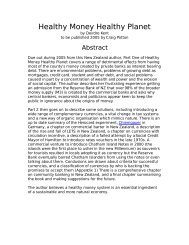Tropical Homegardens - library.uniteddiversity.coop
Tropical Homegardens - library.uniteddiversity.coop
Tropical Homegardens - library.uniteddiversity.coop
You also want an ePaper? Increase the reach of your titles
YUMPU automatically turns print PDFs into web optimized ePapers that Google loves.
36<br />
many cultivate food crops on over 50% of the total area of their property. In Port<br />
Moresby, for example, in Morata and Gerehu suburbs, recently settled in the mid-<br />
1970s, an average of approximately 40% of 450 m 2 allotments were then under food<br />
crops. Similarly, in some cases in Nuku‘alofa, up to 75% of 500 to 1000 m 2<br />
allotments were under food cultivation, primarily root crops (such as yam, taro,<br />
tannia, cassava, and sweet potato) and banana among scattered trees (Thaman,<br />
1995). Trees gradually become dominant in long-settled areas as cash incomes increase,<br />
and tree seedlings mature and increasingly shade garden areas. Nevertheless, in suburbs<br />
such as Gerehu, where trees have matured, socioeconomic status has risen. Although<br />
and the contribution to household economies that homegardens provide has<br />
declined, gardening continues to be important (Levett, 1996).<br />
Ornamentals are commonly planted closest to the home, often in front yards, as<br />
well as in containers on front porches. Medicinal plants, sacred or fragrant plants,<br />
and other culturally valuable, common multipurpose plants, are scattered amongst<br />
the food plants and ornamentals. In gardens of the indigenous Nauruans (who as a<br />
result of phosphate mining royalties, have historically had high per capita incomes),<br />
ornamental, aromatic and medicinal plants dominate, along with the ubiquitous<br />
coconut, edible pandanus, some bananas, and breadfruit. At the Location contract<br />
worker settlement in Nauru, where people live in multistory tenements, and where<br />
family gardening is limited to no more than 15 to 30 m 2 , most families have only a<br />
few plants. The gardens of Tuvaluans and I-Kiribati who live as contract workers in<br />
Nauru often consist of juvenile tree seedlings, staple root crops, or a single coconut<br />
palm or stand of bananas. In the gardens of Chinese (mostly recruited from Hong<br />
Kong) and Filipinos, the emphasis is on intensive vegetable gardening, often in<br />
containers, reflecting a more intensive system than that was practiced by most<br />
indigenous Pacific island peoples. In Kiribati and Tonga, however, recent emphasis<br />
has been placed by the government and non-governmental organizations on more<br />
intensive types of gardening: in Kiribati, using hydroponic and deep mulching<br />
techniques because of the highly infertile calcareous and sandy soils there. In<br />
Kiribati, where vitamin A deficiency-induced night blindness and xerophthalmia<br />
have become problems, the planting and consumption of the vitamin-rich leaves of<br />
two native tree species: noni (Morinda citrifolia) and Pisonia grandis, and more<br />
recently chaya have been encouraged in urban areas (Thaman, 1995).<br />
1.6. Trends toward agrodeforestation<br />
R.R. THAMAN T<br />
ET AL.<br />
Despite the current importance of gardening on open urban and periurban land, these<br />
areas have been severely affected by deforestation and agrodeforestation (Thaman,<br />
1992). Increasing population, poverty, and need for firewood, expansion of squatter<br />
settlements, lack of legislation controlling tree removal, increasing dependence on<br />
root crops such as cassava and sweet potatoes, and the loss of knowledge on the<br />
importance of trees in the context of a rapidly urbanizing Pacific have led to the<br />
increasing elimination of trees from urban landscapes throughout the islands<br />
(Thaman, 2002). In rural areas, promotion of a wide range of export cash crops (e.g.,<br />
coconut, banana, cacao [Theobroma cacao], sugarcane, coffee [Coffea spp.], ginger<br />
[Zingiber officinale], and butter pumpkin [Curcurbita maxima]) has led to the














